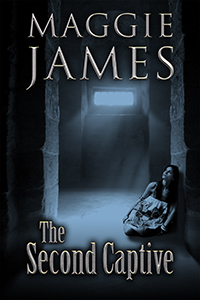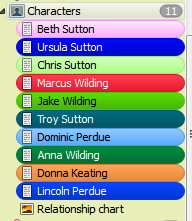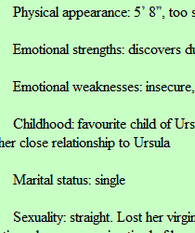How I Create my Characters: Beth Sutton
By Maggie James
'How do you create your characters?'
 As a novelist, I'm often asked how I come up with my characters, as well as how I develop them. It's a good question. Without credible characters, a book's plot, no matter how good, won't hang together. I spend quite a while mapping out my characters and getting to know them during the planning stage of each novel. I thought my readers might be interested in a glimpse of how I do this. With the publication of my fourth novel imminent, I'll concentrate on its protagonist, Beth Sutton, and describe how she came into being.
As a novelist, I'm often asked how I come up with my characters, as well as how I develop them. It's a good question. Without credible characters, a book's plot, no matter how good, won't hang together. I spend quite a while mapping out my characters and getting to know them during the planning stage of each novel. I thought my readers might be interested in a glimpse of how I do this. With the publication of my fourth novel imminent, I'll concentrate on its protagonist, Beth Sutton, and describe how she came into being.
Firstly, how did the idea for the character of Beth come about? Well, I heard about a young woman who returned home after a five-year absence, refusing to say where she'd been or why she left. Immediately, my curiosity was piqued. What circumstances led to her disappearance? And why wouldn't she talk about what happened? The notion of Stockholm syndrome immediately came to mind. For psychological suspense novelists, it's a condition that provides a wealth of possibilities.
So what is Stockhom syndrome? It's the tendency of a hostage to bond with his or her captor. It may sound unbelievable to those of us fortunate never to have experienced such a situation, but victims can and do empathise with their captors. Notable sufferers have included Patty Hearst, kidnapped by the Symbionese Liberation Army in 1974, but who later joined forces with their cause. I've written more about the condition here. This is what happens to Beth in The Second Captive. Getting the right name for a character
 Screen clip from Scrivener Once I had the idea of a young woman who's abducted and falls victim to Stockholm syndrome, the character of Beth Sutton was born. Next, I needed to find a name for her. Unlike my novel titles, I find naming characters fairly easy. Obviously, the moniker I give them has to gel with their age and social background - so Beth, being a young woman, couldn't be called Mabel, Dorothy or Gladys. The name has to fit well in other ways, too. Sophie, for example, has a soft edge to it, conjuring up images of a gentle, kind soul. Therefore it's not a name I'd use for a psychotic killer, for example. Dominique has overtones of control, so I'd pick a name like that for a strong, sassy female character. In fact, the antagonist in the novel, a male character, is called Dominic, and he's definitely someone who likes to be in control. His surname is Perdue, a corruption of the French word for lost; in many ways, he's a lost soul, and foreign languages also feature in the novel.
Screen clip from Scrivener Once I had the idea of a young woman who's abducted and falls victim to Stockholm syndrome, the character of Beth Sutton was born. Next, I needed to find a name for her. Unlike my novel titles, I find naming characters fairly easy. Obviously, the moniker I give them has to gel with their age and social background - so Beth, being a young woman, couldn't be called Mabel, Dorothy or Gladys. The name has to fit well in other ways, too. Sophie, for example, has a soft edge to it, conjuring up images of a gentle, kind soul. Therefore it's not a name I'd use for a psychotic killer, for example. Dominique has overtones of control, so I'd pick a name like that for a strong, sassy female character. In fact, the antagonist in the novel, a male character, is called Dominic, and he's definitely someone who likes to be in control. His surname is Perdue, a corruption of the French word for lost; in many ways, he's a lost soul, and foreign languages also feature in the novel.
To find the right first name, I check possibilities on a baby-naming website, choosing one that feels right when attached to the character in my head. Same with the surname; there are plenty of websites that give the origin of surnames, and I use them to find the right one for my character. Once I have the first and last name, ones that sound good when put together, I go with that.
Next, I set up a tab for him/her in the wonderful software I use, called Scrivener. I employ Scrivener for every part of the writing process; it keeps me organised and compiles my manuscript seamlessly into Kindle format once I'm done. The screen clip above is from The Secret Captive files in Scrivener, showing the section I've used for character creation, along with a chart showing the relationships between them.
What challenges will my character face?
 Actress Emilia Clarke Once I'd set up a tab for Beth Sutton, I used it to work on her character. Scrivener is very flexible, so I can do this any way I chose. What I usually do is to hold the character in my head, whilst answering a series of questions about them, noting the answers in the Scrivener tab.
Actress Emilia Clarke Once I'd set up a tab for Beth Sutton, I used it to work on her character. Scrivener is very flexible, so I can do this any way I chose. What I usually do is to hold the character in my head, whilst answering a series of questions about them, noting the answers in the Scrivener tab.
First come the obvious details, like height, weight, hair colour, etc. Beth Sutton is eighteen years old at the time of her abduction, slim, 5' 8" tall, with long dark hair and matching eyes. Under her right eye, she has a tiny mole. Very like actress Emilia Clarke, pictured left. That's how she appeared in my head, so I went with it; it would be hard to write about her as a 6' blonde when she doesn't appear that way in my mind. As for the mole, I like to give my characters at least one distinguishing feature, helping to make them more real in my readers' minds. For the book's antagonist, Dominic Perdue, I created him with eyes that are mismatched in colour, reflecting the split in his personality between sociopathic kidnapper and lonely, damaged man.
Once I've worked through the physical characteristics, I move on to the mental and emotional ones. Beth, for example, needed to be naive and in search of meaning in her life. Attributes that render her vulnerable to Dominic Perdue's plan to abduct her. The plot wouldn't have worked had I made her a sassy, confident woman. Or prehaps it would have worked, but have gone in an entirely different direction! The need for her to be emotionally immature is also the reason I made her eighteen years of age. She's fresh out of school, still living at home, doesn't know her arse from her elbow. All the more reason Dominic is able to prey on her.
Questions to flesh out my characters
 Screen clip from Scrivener The list of questions I work through is long, covering areas such as sexuality, marital status and education. Not all are useful; Beth's political views, for example, are not relevant in any way to the plot of the Second Captive, but I noted them down anyway. It's good to have as comprehensive a knowledge of a character as possible, even if the information is never used. It all helps flesh them into reality when I come to write the novel.
Screen clip from Scrivener The list of questions I work through is long, covering areas such as sexuality, marital status and education. Not all are useful; Beth's political views, for example, are not relevant in any way to the plot of the Second Captive, but I noted them down anyway. It's good to have as comprehensive a knowledge of a character as possible, even if the information is never used. It all helps flesh them into reality when I come to write the novel.
I also ask other, more oblique, questions. What is Beth Sutton most afraid of? What does she want from life? What obstacles will she face during the course of the novel? How will she deal with these issues? For Beth, her challenges are two-fold. First, to survive the horror of being incarcerated for two years in a basement. After she escapes, though, her problems aren't over. Stockholm syndrome bites into her during her abduction, and hard. Once she's free, she finds it's not so easy to shake off her ordeal.
By the time I'd finished, I had a detailed knowledge of Beth Sutton in my head. The clearer the image I hold in my mind of a character, the more comprehensive the knowledge I have of them, the better I can portray him/her. I don't want to have to interrupt my writing by stopping to consider 'how would Beth react in such a situation? What would she say?' I need to know her inside out, down to her bones, so well that I don't need to refer to my notes in Scrivener. Now that Beth's been part of my life for the last nine months, I reckon I've got pretty well acquainted with her!
Any questions? Leave me a comment!
 I hope that you have found this post interesting, and that it's given you an insight into how we novelists create our characters! Well, how I do, anyway - obviously everyone is different. Some authors prefer a more relaxed approach, allowing their characters to develop as the plot progresses, without much prior knowledge of them. I can see the advantages in that, and how it might make the writing process more fun. Me, though, I'm a planner. I work best when I have the plot and characters fully fleshed out before I start to write. Each to their own!
I hope that you have found this post interesting, and that it's given you an insight into how we novelists create our characters! Well, how I do, anyway - obviously everyone is different. Some authors prefer a more relaxed approach, allowing their characters to develop as the plot progresses, without much prior knowledge of them. I can see the advantages in that, and how it might make the writing process more fun. Me, though, I'm a planner. I work best when I have the plot and characters fully fleshed out before I start to write. Each to their own!
Let me know if you have any questions. Next week, I'll be posting about the plotting process. I'll explain how The Second Captive went from a rough idea to a fully-fledged novel.
The Second Captive is now available for pre-order!
 I'm delighted to report that my fourth novel, The Second Captive, is now available on Amazon in Kindle format via their pre-order system. Publication date will be November 24, with the paperback version following shortly afterwards. I'm releasing the book at a discounted price of $0.99/£0.99 for the first week only, rising on December 1 to $4.80/£3.29. Grab a copy whilst it's on sale! Here's the link.
I'm delighted to report that my fourth novel, The Second Captive, is now available on Amazon in Kindle format via their pre-order system. Publication date will be November 24, with the paperback version following shortly afterwards. I'm releasing the book at a discounted price of $0.99/£0.99 for the first week only, rising on December 1 to $4.80/£3.29. Grab a copy whilst it's on sale! Here's the link.
Subscribe to my newsletter and blog!
 I'd love to stay in contact with you! Why not sign up for my newsletter? It's an occasional communication to keep you informed about my new novel releases. I respect your privacy and will never sell your details to any third parties. To sign up, enter your details in the form at the top of the sidebar.
I'd love to stay in contact with you! Why not sign up for my newsletter? It's an occasional communication to keep you informed about my new novel releases. I respect your privacy and will never sell your details to any third parties. To sign up, enter your details in the form at the top of the sidebar.
And if you've enjoyed this blog post, how about subscribing via RSS feed or email? Either click the links in my blog sidebar or sign up via Networked Blogs, also in the sidebar. It'll be great to have you on board!
'How do you create your characters?'
 As a novelist, I'm often asked how I come up with my characters, as well as how I develop them. It's a good question. Without credible characters, a book's plot, no matter how good, won't hang together. I spend quite a while mapping out my characters and getting to know them during the planning stage of each novel. I thought my readers might be interested in a glimpse of how I do this. With the publication of my fourth novel imminent, I'll concentrate on its protagonist, Beth Sutton, and describe how she came into being.
As a novelist, I'm often asked how I come up with my characters, as well as how I develop them. It's a good question. Without credible characters, a book's plot, no matter how good, won't hang together. I spend quite a while mapping out my characters and getting to know them during the planning stage of each novel. I thought my readers might be interested in a glimpse of how I do this. With the publication of my fourth novel imminent, I'll concentrate on its protagonist, Beth Sutton, and describe how she came into being.Firstly, how did the idea for the character of Beth come about? Well, I heard about a young woman who returned home after a five-year absence, refusing to say where she'd been or why she left. Immediately, my curiosity was piqued. What circumstances led to her disappearance? And why wouldn't she talk about what happened? The notion of Stockholm syndrome immediately came to mind. For psychological suspense novelists, it's a condition that provides a wealth of possibilities.
So what is Stockhom syndrome? It's the tendency of a hostage to bond with his or her captor. It may sound unbelievable to those of us fortunate never to have experienced such a situation, but victims can and do empathise with their captors. Notable sufferers have included Patty Hearst, kidnapped by the Symbionese Liberation Army in 1974, but who later joined forces with their cause. I've written more about the condition here. This is what happens to Beth in The Second Captive. Getting the right name for a character
 Screen clip from Scrivener Once I had the idea of a young woman who's abducted and falls victim to Stockholm syndrome, the character of Beth Sutton was born. Next, I needed to find a name for her. Unlike my novel titles, I find naming characters fairly easy. Obviously, the moniker I give them has to gel with their age and social background - so Beth, being a young woman, couldn't be called Mabel, Dorothy or Gladys. The name has to fit well in other ways, too. Sophie, for example, has a soft edge to it, conjuring up images of a gentle, kind soul. Therefore it's not a name I'd use for a psychotic killer, for example. Dominique has overtones of control, so I'd pick a name like that for a strong, sassy female character. In fact, the antagonist in the novel, a male character, is called Dominic, and he's definitely someone who likes to be in control. His surname is Perdue, a corruption of the French word for lost; in many ways, he's a lost soul, and foreign languages also feature in the novel.
Screen clip from Scrivener Once I had the idea of a young woman who's abducted and falls victim to Stockholm syndrome, the character of Beth Sutton was born. Next, I needed to find a name for her. Unlike my novel titles, I find naming characters fairly easy. Obviously, the moniker I give them has to gel with their age and social background - so Beth, being a young woman, couldn't be called Mabel, Dorothy or Gladys. The name has to fit well in other ways, too. Sophie, for example, has a soft edge to it, conjuring up images of a gentle, kind soul. Therefore it's not a name I'd use for a psychotic killer, for example. Dominique has overtones of control, so I'd pick a name like that for a strong, sassy female character. In fact, the antagonist in the novel, a male character, is called Dominic, and he's definitely someone who likes to be in control. His surname is Perdue, a corruption of the French word for lost; in many ways, he's a lost soul, and foreign languages also feature in the novel.To find the right first name, I check possibilities on a baby-naming website, choosing one that feels right when attached to the character in my head. Same with the surname; there are plenty of websites that give the origin of surnames, and I use them to find the right one for my character. Once I have the first and last name, ones that sound good when put together, I go with that.
Next, I set up a tab for him/her in the wonderful software I use, called Scrivener. I employ Scrivener for every part of the writing process; it keeps me organised and compiles my manuscript seamlessly into Kindle format once I'm done. The screen clip above is from The Secret Captive files in Scrivener, showing the section I've used for character creation, along with a chart showing the relationships between them.
What challenges will my character face?
 Actress Emilia Clarke Once I'd set up a tab for Beth Sutton, I used it to work on her character. Scrivener is very flexible, so I can do this any way I chose. What I usually do is to hold the character in my head, whilst answering a series of questions about them, noting the answers in the Scrivener tab.
Actress Emilia Clarke Once I'd set up a tab for Beth Sutton, I used it to work on her character. Scrivener is very flexible, so I can do this any way I chose. What I usually do is to hold the character in my head, whilst answering a series of questions about them, noting the answers in the Scrivener tab.First come the obvious details, like height, weight, hair colour, etc. Beth Sutton is eighteen years old at the time of her abduction, slim, 5' 8" tall, with long dark hair and matching eyes. Under her right eye, she has a tiny mole. Very like actress Emilia Clarke, pictured left. That's how she appeared in my head, so I went with it; it would be hard to write about her as a 6' blonde when she doesn't appear that way in my mind. As for the mole, I like to give my characters at least one distinguishing feature, helping to make them more real in my readers' minds. For the book's antagonist, Dominic Perdue, I created him with eyes that are mismatched in colour, reflecting the split in his personality between sociopathic kidnapper and lonely, damaged man.
Once I've worked through the physical characteristics, I move on to the mental and emotional ones. Beth, for example, needed to be naive and in search of meaning in her life. Attributes that render her vulnerable to Dominic Perdue's plan to abduct her. The plot wouldn't have worked had I made her a sassy, confident woman. Or prehaps it would have worked, but have gone in an entirely different direction! The need for her to be emotionally immature is also the reason I made her eighteen years of age. She's fresh out of school, still living at home, doesn't know her arse from her elbow. All the more reason Dominic is able to prey on her.
Questions to flesh out my characters
 Screen clip from Scrivener The list of questions I work through is long, covering areas such as sexuality, marital status and education. Not all are useful; Beth's political views, for example, are not relevant in any way to the plot of the Second Captive, but I noted them down anyway. It's good to have as comprehensive a knowledge of a character as possible, even if the information is never used. It all helps flesh them into reality when I come to write the novel.
Screen clip from Scrivener The list of questions I work through is long, covering areas such as sexuality, marital status and education. Not all are useful; Beth's political views, for example, are not relevant in any way to the plot of the Second Captive, but I noted them down anyway. It's good to have as comprehensive a knowledge of a character as possible, even if the information is never used. It all helps flesh them into reality when I come to write the novel.I also ask other, more oblique, questions. What is Beth Sutton most afraid of? What does she want from life? What obstacles will she face during the course of the novel? How will she deal with these issues? For Beth, her challenges are two-fold. First, to survive the horror of being incarcerated for two years in a basement. After she escapes, though, her problems aren't over. Stockholm syndrome bites into her during her abduction, and hard. Once she's free, she finds it's not so easy to shake off her ordeal.
By the time I'd finished, I had a detailed knowledge of Beth Sutton in my head. The clearer the image I hold in my mind of a character, the more comprehensive the knowledge I have of them, the better I can portray him/her. I don't want to have to interrupt my writing by stopping to consider 'how would Beth react in such a situation? What would she say?' I need to know her inside out, down to her bones, so well that I don't need to refer to my notes in Scrivener. Now that Beth's been part of my life for the last nine months, I reckon I've got pretty well acquainted with her!
Any questions? Leave me a comment!
 I hope that you have found this post interesting, and that it's given you an insight into how we novelists create our characters! Well, how I do, anyway - obviously everyone is different. Some authors prefer a more relaxed approach, allowing their characters to develop as the plot progresses, without much prior knowledge of them. I can see the advantages in that, and how it might make the writing process more fun. Me, though, I'm a planner. I work best when I have the plot and characters fully fleshed out before I start to write. Each to their own!
I hope that you have found this post interesting, and that it's given you an insight into how we novelists create our characters! Well, how I do, anyway - obviously everyone is different. Some authors prefer a more relaxed approach, allowing their characters to develop as the plot progresses, without much prior knowledge of them. I can see the advantages in that, and how it might make the writing process more fun. Me, though, I'm a planner. I work best when I have the plot and characters fully fleshed out before I start to write. Each to their own!Let me know if you have any questions. Next week, I'll be posting about the plotting process. I'll explain how The Second Captive went from a rough idea to a fully-fledged novel.
The Second Captive is now available for pre-order!
 I'm delighted to report that my fourth novel, The Second Captive, is now available on Amazon in Kindle format via their pre-order system. Publication date will be November 24, with the paperback version following shortly afterwards. I'm releasing the book at a discounted price of $0.99/£0.99 for the first week only, rising on December 1 to $4.80/£3.29. Grab a copy whilst it's on sale! Here's the link.
I'm delighted to report that my fourth novel, The Second Captive, is now available on Amazon in Kindle format via their pre-order system. Publication date will be November 24, with the paperback version following shortly afterwards. I'm releasing the book at a discounted price of $0.99/£0.99 for the first week only, rising on December 1 to $4.80/£3.29. Grab a copy whilst it's on sale! Here's the link.Subscribe to my newsletter and blog!
 I'd love to stay in contact with you! Why not sign up for my newsletter? It's an occasional communication to keep you informed about my new novel releases. I respect your privacy and will never sell your details to any third parties. To sign up, enter your details in the form at the top of the sidebar.
I'd love to stay in contact with you! Why not sign up for my newsletter? It's an occasional communication to keep you informed about my new novel releases. I respect your privacy and will never sell your details to any third parties. To sign up, enter your details in the form at the top of the sidebar.And if you've enjoyed this blog post, how about subscribing via RSS feed or email? Either click the links in my blog sidebar or sign up via Networked Blogs, also in the sidebar. It'll be great to have you on board!
Published on November 14, 2014 06:43
No comments have been added yet.



